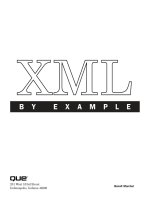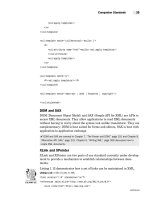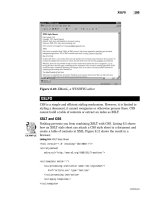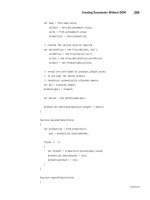RUBY BY EXAMPLE pot
Bạn đang xem bản rút gọn của tài liệu. Xem và tải ngay bản đầy đủ của tài liệu tại đây (8.19 MB, 310 trang )
There may be no better way to learn how to program
than by dissecting real, representative examples written
in your language of choice. In Ruby by Example, author
Kevin Baird analyzes 44 Ruby scripts, offering step-by-
step explanations of how the code works and how to
modify it to fit your needs.
Baird’s examples demonstrate key features of the
language (such as inheritance, encapsulation, higher-
order functions, and recursion), while simultaneously
solving difficult problems (such as validating XML,
creating a bilingual program, and creating command-
line interfaces). Each chapter builds upon the next,
and each key concept is highlighted in the margin to
make it easier for you to navigate the book.
You’ll learn how to:
• Use the interactive Ruby shell (irb) to learn key
features of the language
• Extend Ruby using RubyGems, the Ruby package
manager
• Create numerical utilities, as well as utilities that
process and analyze HTML/XML
• Implement purely functional and metaprogramming
techniques to save time and effort
www.nostarch.com
TH E FI N EST I N G E E K E N T E RTA I N M E NT
™
SHELVE IN:
PROGRAMMING/RUBY
$34.95 ($43.95 CDN)
®
• Optimize, profile, and test your code to make sure
that it not only does its job, but does it well
• Create complex utilities that model natural selection,
discover mysterious patterns in the Bible (and in
Moby-Dick) that “predict” the future, and pick songs
to play for a radio station
• Create web applications using Rails
Ruby is the fastest growing programming language
today, and for good reason: Its elegant syntax
and readable code make for prolific and happy
programmers. But it can be difficult to understand
and implement without a little help. Ruby by Example
shows you how to take advantage of Ruby as you
explore Ruby’s fundamental concepts in action.
A B O U T T H E A U T H O R
Kevin C. Baird received his Ph.D. from the State
University of New York at Buffalo. He originally wrote
his dissertation in Python but rewrote the project after
discovering Ruby, and he hasn’t looked back since.
He has presented at RubyConf and written articles
for Linux Journal, Music & Computers magazine, and
the New Interfaces for Musical Expression conference
proceedings.
E X P L O R I N G
F U N C T I O N A L
C O D E
E X P L O R I N G
F U N C T I O N A L
C O D E
“I LAY F L A T .”
This book uses RepKover — a durable binding that won’t snap shut.
Printed on recycled paper
R U B Y
B Y E X A M P L E
R U B Y
B Y E X A M P L E
K E V I N C . B A I R D
®
C O N C E P T S A N D C O D E
R U B Y B Y E X A M P L E
R U B Y B Y E X A M P L E
B A I R D
RUBY BY EXAMPLE
RUBY BY EXAMPLE
Concepts and Code
by Kevin C. Baird
San Francisco
®
RUBY BY EXAMPLE. Copyright © 2007 by Kevin C. Baird.
All rights reserved. No part of this work may be reproduced or transmitted in any form or by any means, electronic or
mechanical, including photocopying, recording, or by any information storage or retrieval system, without the prior
written permission of the copyright owner and the publisher.
11 10 09 08 07 1 2 3 4 5 6 7 8 9
ISBN-10: 1-59327-148-4
ISBN-13: 978-1-59327-148-0
Publisher: William Pollock
Production Editor: Elizabeth Campbell
Cover and Interior Design: Octopod Studios
Developmental Editor: Tyler Ortman
Technical Reviewer: Pat Eyler
Copyeditor: Megan Dunchak
Compositors: Christina Samuell and Riley Hoffman
Proofreader: Publication Services, Inc.
Indexer: Nancy Guenther
For information on book distributors or translations, please contact No Starch Press, Inc. directly:
No Starch Press, Inc.
555 De Haro Street, Suite 250, San Francisco, CA 94107
phone: 415.863.9900; fax: 415.863.9950; ; www.nostarch.com
Library of Congress Cataloging-in-Publication Data
Baird, Kevin C.
Ruby by example : concepts and code / Kevin C. Baird.
p. cm.
Includes index.
ISBN-13: 978-1-59327-148-0
ISBN-10: 1-59327-148-4
1. Object-oriented programming (Computer science) 2. Ruby (Computer program language) I. Title.
QA76.64.B27 2007
005.1'17 dc22
2007018653
No Starch Press and the No Starch Press logo are registered trademarks of No Starch Press, Inc. Other product and
company names mentioned herein may be the trademarks of their respective owners. Rather than use a trademark
symbol with every occurrence of a trademarked name, we are using the names only in an editorial fashion and to the
benefit of the trademark owner, with no intention of infringement of the trademark.
The information in this book is distributed on an “As Is” basis, without warranty. While every precaution has been
taken in the preparation of this work, neither the author nor No Starch Press, Inc. shall have any liability to any
person or entity with respect to any loss or damage caused or alleged to be caused directly or indirectly by the
information contained in it.
Printed on recycled paper in the United States of America
This book is dedicated to my parents, who bought
the first computer I ever programmed.
BRIEF CONTENTS
Acknowledgments xvii
Introduction: What Is Ruby? xix
Chapter 1: Interactive Ruby and the Ruby Environment 1
Chapter 2: Amusements and Simple Utilities 13
Chapter 3: Programmer Utilities 33
Chapter 4: Text Manipulation 51
Chapter 5: Number Utilities 71
Chapter 6: Functionalism with Blocks and Procs 99
Chapter 7: Using, Optimizing, and Testing Functional Techniques 121
Chapter 8: HTML and XML Tools 141
Chapter 9: More Complex Utilities and Tricks, Part I 161
Chapter 10: More Complex Utilities and Tricks, Part II 185
Chapter 11: CGI and the Web 205
Chapter 12: RubyGems and Rails Preparation 223
Chapter 13: A Simple Rails Project 237
Appendix: How Does Ruby Compare to Other Languages? 261
Index 267
CONTENTS IN DETAIL
ACKNOWLEDGMENTS xvii
INTRODUCTION: WHAT IS RUBY? xix
Acquiring and Configuring Ruby xx
On a Unix or Unix-like System xx
On a Windows System xxi
Motivations for the Book xxi
Conventions xxii
Summary of Chapters xxii
1
INTERACTIVE RUBY AND THE RUBY ENVIRONMENT 1
Starting irb 2
Using irb 2
Expressions 2
Everything Is an Object 2
Integers, Fixnums, and Bignums 3
Addition, Concatenation, and Exceptions 4
Casting 4
Arrays 5
Booleans 6
Flow Control 6
Methods 8
Variables 9
Constants 10
Using the Ruby Interpreter and Environment 10
2
AMUSEMENTS AND SIMPLE UTILITIES 13
#1 Is It Payday? (check_payday.rb) 14
The Code 14
How It Works 14
The Results 16
#2 Random Signature Generator (random_sig.rb and random_sig-windows.rb) 16
The Code 16
How It Works 16
Running the Script 19
The Results 19
Hacking the Script 19
#3 The 99 Bottles of Beer Song (99bottles.rb) 20
The Code 20
How It Works 21
x Contents in Detail
Running the Script 25
The Results 25
#4 Sound File Player (shuffle_play.rb) 25
The Code 26
How It Works 27
Running the Script 29
The Results 29
Hacking the Script 30
Chapter Recap 31
3
PROGRAMMER UTILITIES 33
#5 What Is Truth? (boolean_golf.rb) 33
The Code 34
How It Works 34
Hacking the Script 36
Running the Script 36
The Results 36
#6 Making a List (array_join.rb) 36
The Code 37
How It Works 37
Running the Script 39
Hacking the Script 39
#7 Command-Line Interface (uses_cli.rb and simple_cli.rb) 39
The Code 40
How It Works 42
Running the Script 44
Hacking the Script 45
#8 Palindromes (palindrome.rb and palindrome2.rb) 45
The Code 45
How It Works 46
Hacking the Script 46
Running the Script 47
The Results 48
Chapter Recap 49
4
TEXT MANIPULATION 51
#9 End-of-Line Conversion (dos2unix.rb) 51
The Code 52
How It Works 52
Running the Script 55
The Results 56
Hacking the Script 56
#10 Showing Line Numbers (line_num.rb) 57
The Code 57
How It Works 57
Running the Script 58
The Results 58
Contents in Detail xi
#11 Wrapping Lines of Text (softwrap.rb) 59
The Code 59
Running the Script 62
The Results 62
Hacking the Script 62
#12 Counting Words in a File (word_count.rb) 62
The Code 63
How It Works 64
Running the Script 64
The Results 64
#13 Word Histogram (most_common_words.rb) 65
The Code 65
How It Works 65
Running the Script 67
The Results 67
Hacking the Script 67
#14 Rotating Characters in a String (rotate.rb) 68
The Code 68
How It Works 68
Running the Script 69
The Results 69
Chapter Recap 70
5
NUMBER UTILITIES 71
#15 Computing Powers (power_of.rb) 72
The Code 72
How It Works 73
Running the Script 74
The Results 75
#16 Adding Commas to Numbers (commify.rb) 75
Inheritance 75
Modules 76
The Code 76
How It Works 78
Running the Script 81
The Results 81
#17 Roman Numerals (roman_numeral.rb) 81
The Code 82
How It Works 83
Running the Script 86
The Results 86
Hacking the Script 87
#18 Currency Conversion, Basic (currency_converter1.rb) 87
The Code 88
How It Works 89
Running the Script 90
The Results 90
Hacking the Script 90
xii Contents in Detail
#19 Currency Conversion, Advanced (currency_converter2.rb) 90
The Code 91
How It Works 93
Running the Script 97
The Results 97
Hacking the Script 98
Chapter Recap 98
6
FUNCTIONALISM WITH BLOCKS AND PROCS 99
#20 Our First lambda (make_incrementer.rb) 100
The Code 100
How It Works 101
The Results 101
#21 Using Procs for Filtering (matching_members.rb) 102
The Code 102
How It Works 102
Running the Script 103
The Results 103
#22 Using Procs for Compounded Filtering (matching_compound_members.rb) 103
The Code 104
How It Works 105
The Results 107
Hacking the Script 108
#23 Returning Procs as Values (return_proc.rb) 108
The Code 108
The Results 109
How It Works 109
#24 Nesting lambdas 111
The Code 111
How It Works 112
#25 Procs for Text (willow_and_anya.rb) 112
The Code 112
How It Works 115
Running the Script 118
The Results 118
Hacking the Script 119
Chapter Recap 119
7
USING, OPTIMIZING, AND TESTING FUNCTIONAL
TECHNIQUES 121
#26 Basic Factorials and Fibonaccis (factorial1.rb through fibonacci5.rb) 122
The Code 122
How It Works 123
The Results 123
Hacking the Script 124
Contents in Detail xiii
#27 Benchmarking and Profiling (tests/test_opts.rb) 128
Benchmarking 128
The Code 128
How It Works 129
Running the Script 130
The Results 130
Profiling 131
Hacking the Script 132
#28 Converting Temperatures (temperature_converter.rb) 132
The Code 132
How It Works 134
The Results 136
Hacking the Script 136
#29 Testing temperature_converter.rb (tests/test_temp_converter.rb) 137
The Code 137
The Results 138
How It Works 139
Hacking the Script 139
Chapter Recap 140
8
HTML AND XML TOOLS 141
#30 Cleaning Up HTML (html_tidy.rb) 141
The Code 142
How It Works 144
Running the Script 146
The Results 147
Hacking the Script 148
#31 Counting Tags (xml_tag_counter.rb) 148
The Code 149
How It Works 150
Running the Script 153
The Results 153
Hacking the Script 153
#32 Extracting Text from XML (xml_text_extractor.rb) 154
The Code 154
How It Works 155
Running the Script 155
The Results 155
Hacking the Script 156
#33 Validating XML (xml_well_formedness_checker.rb) 156
The Code 156
How It Works 157
Running the Script 158
The Results 158
Hacking the Script 158
Chapter Recap 159
xiv Contents in Detail
9
MORE COMPLEX UTILITIES AND TRICKS, PART I 161
#34 Finding Codes in the Bible or Moby-Dick (els_parser.rb) 161
The Code 162
How It Works 164
Running the Script 167
The Results 167
Hacking the Script 168
#35 Mutating Strings into Weasels (methinks.rb) 168
The Code 168
How It Works 171
Running the Script 174
The Results 174
Hacking the Script 175
#36 Mutating the Mutation of Strings into Weasels (methinks_meta.rb) 176
The Code 177
How It Works 179
Running the Script 181
The Results 181
Hacking the Script 182
Chapter Recap 183
10
MORE COMPLEX UTILITIES AND TRICKS, PART II 185
#37 Overnight DJ (radio_player1.rb) 186
The Code 186
How It Works 187
The Results 189
Hacking the Script 190
#38 Better Overnight DJ (radio_player2.rb) 190
The Code 190
How It Works 191
The Results 192
Hacking the Script 193
#39 Numbers by Name (to_lang.rb) 193
The Code 194
How It Works 198
The Results 201
Hacking the Script 202
#40 Elegant Maps and Injects (symbol.rb) 203
The Code 203
How It Works 203
The Results 204
Hacking the Script 204
Chapter Recap 204
Contents in Detail xv
11
CGI AND THE WEB 205
Common Gateway Interface 206
Preparation and Installation 206
#41 A Simple CGI Script (simple_cgi.rb) 207
The Code 207
How It Works 208
The Results 210
Hacking the Script 210
#42 Mod Ruby (mod_ruby_demo.rhtml and mod_ruby_demo.conf) 211
The Code 211
How It Works 213
The Results 214
Hacking the Script 214
#43 CSS Stylesheets, Part I (stylesheet.rcss) 215
The Code 215
How It Works 216
The Results 217
Hacking the Script 218
#44 CSS Stylesheets, Part II (stylesheet2.rcss) 218
The Code 218
How It Works 220
The Results 220
Hacking the Script 221
Chapter Recap 221
12
RUBYGEMS AND RAILS PREPARATION 223
RubyGems 223
Installing RubyGems 224
Using RubyGems 224
Rails Preparation 227
What Is Rails? 228
Other Options for Installing Rails 228
Databases 229
The Structure of a Rails Application 229
Chapter Recap 235
13
A SIMPLE RAILS PROJECT 237
Creating the Application 237
Initial Creation 238
Preparing the Database 238
Adding Data 238
Creating the Model and Controllers 240
xvi Contents in Detail
Dissecting the Application 241
Dissecting the Photo Model 241
Dissecting the Controllers 242
Dissecting the Helpers 245
Dissecting the Album Controller’s Views 251
Dissecting the Feed Controller’s images View 254
Dissecting the Album Controller’s Layout 256
Using CSS 257
Using the Application 257
Learning More About Rails 260
Chapter Recap 260
APPENDIX
HOW DOES RUBY COMPARE TO OTHER LANGUAGES? 261
C 261
Haskell 262
Java 262
Lisp 263
Perl 264
PHP 264
Python 265
Smalltalk 265
Summary of Ruby vs. Other Languages 266
INDEX 267
ACKNOWLEDGMENTS
The most fervent thanks are due to my wife, Jennifer
Cornish, who put up with my focusing too much on
this book while she was finishing up her doctoral
dissertation.
Thanks to Jon Phillips, Michael Ivancic, Aubrey Keus, and Scott Bliss for
helpful comments. Jon Phillips in particular gave very useful technical advice
in the early stages of writing, and I think of him as the unofficial early tech
reviewer. Thanks are obviously also due to the official tech reviewer Pat Eyler,
whose influence made this is a much better book than it would otherwise
have been.
Thanks as well to professors Richard Dawkins of Oxford University and
Brendan McKay of the Australian National University for their cooperation
in my referencing their work.
Finally, thanks to everyone at No Starch Press and to Matz for creating
Ruby in the first place.
INTRODUCTION:
WHAT IS RUBY?
Ruby is “a dynamic, open source programming language
with a focus on simplicity and productivity. It has an
elegant syntax that is natural to read and easy to write.”
1
It was released in 1995 by Yukihiro “Matz” Matsumoto.
It is often described as either a very high-level language or a scripting language,
depending on whom you ask. As such, it doesn’t require a programmer to
specify the details of how the computer implements your decisions. Like
other high-level languages, Ruby is often used in text-processing applications,
including an increasing number of web applications. I hope that once you’ve
become more acquainted with the language, you’ll agree that it does a good
job of getting out of your way and simply letting you get some work done.
Ruby has a very interesting pedigree. Matz himself has said that the
two most influential languages on Ruby’s design were Common Lisp and
Smalltalk—they were so influential, in fact, that he has jokingly referred to
Ruby as MatzLisp. On the other hand, some Ruby aficionados stress Ruby’s
1
According to .
xx Introduction: What Is Ruby?
similarities with Smalltalk and Perl, as did David Heinemeier Hansson,
creator of Rails, in a June 2006 Linux Journal interview. Hansson also describes
Ruby as “a language for writing beautiful code that makes programmers
happy.” I couldn’t agree more.
2
NOTE If you’re interested in learning more about Ruby’s heritage, see the appendix for
a comparison of Ruby to other languages.
Acquiring and Configuring Ruby
But enough with the history—let’s set these questions aside and actually get
Ruby installed. It’s flexible, expressive, and released under a free software/open
source license. (The license is available online at />about/license.txt.)
On a Unix or Unix-like System
Users of Unix-like operating systems such as Mac OS X, the BSDs, and GNU/
Linux variants have it easy. Many of these systems either come with Ruby pre-
installed or make it available as a very convenient package.
If Ruby came pre-installed on your computer, it will probably include the
Interactive Ruby Shell (irb) that we’ll use in the next chapter. If you’ve installed
Ruby with a package manager, irb may come in a separate package, possibly
with a specific version number as a part of the package name.
If your package manager does not include Ruby or if you’d like to use a
more up-to-date version than what your package manager offers, you can simply
browse to and click the Download Ruby link. Down-
load the current stable release (1.8.4 at the time of this writing), which is a
.tar.gz file. Then type the following commands as the superuser, also called
root. (I’ll assume you’re using version 1.8.4, although it will probably be a
later version when you download Ruby.)
cp ruby-1.8.4.tar.gz /usr/local/src/
cd /usr/local/src
tar -xzf ruby-1.8.4.tar.gz
cd ruby-1.8.4
Then follow the instructions in the README file. The usual set of
commands for installation is as follows.
./configure
make
make install
2
For more on Ruby’s ancestry, refer to the Ruby-Talk archives (
.jp/cgi-bin/scat.rb/ruby/ruby-talk/179642) and O’Reilly’s interview with Matz (http://
www.linuxdevcenter.com/pub/a/linux/2001/11/29/ruby.html).
Introduction: What Is Ruby? xxi
You should now have a working version of Ruby. You can test this by
executing this command:
ruby version
If it reports ruby 1.8.4 (2005-12-24) [i486-linux] or whichever version you
downloaded and your system, everything worked.
3
On a Windows System
If you use a Windows system, a One-Click Ruby Installer is available at
Simply follow the instructions
there to download Ruby for your system. It’s a comprehensive package—check
the site for the most up-to-date list of its contents. At the time of this writing,
it included the base language with various popular extensions, including
SciTE (a syntax-highlighting text editor), FreeRIDE (a Ruby development
environment), a help file containing Dave Thomas’ book Programming Ruby
(also called The Pickaxe), and the RubyGems package installer. It also comes
with irb, which we’ll explore in Chapter 1.
Motivations for the Book
This book tries to be both useful in the immediate term and informative in the
long term. These goals have a profound impact on how the book is organized.
It's also meant to be accessible to neophytes, but it focuses on program-
ming paradigms and their impact on both language design and language
use—topics common to academic programming books. These days, you can
use any popular language for most tasks, but that doesn’t mean that solving a
given problem will be equally painless in every language. No language exists
in a vacuum, and a discussion of a language like Ruby should acknowledge the
decisions that went into its design. You’ll find that it’s a very flexible language
that lets you combine different approaches in powerful ways. Biologists
recognize hybrid vigor; so did Matz when he created Ruby.
NOTE When I mention programming paradigms, I’m referring to three main types: imperative,
object-oriented, and functional. Broadly speaking, imperative languages tell computers
Do this, then do that, then do this next thing. Object-oriented languages
define objects (types of things) that know how to perform methods (specific actions).
Functional languages treat programming problems like mathematical relationships.
Ruby is flexible, meaning that you can program in any of these styles; however, it is
primarily object oriented, with some strong functional influence. This book focuses
slightly more on the functional aspects of Ruby than some other books.
3
Ruby, like most open source languages, is under constant development. The code in this book
uses Ruby version 1.8.4, which was the stable release at the time I wrote the scripts in this book.
Ruby version 1.8.6 was released slightly before this book came out.
xxii Introduction: What Is Ruby?
Conventions
This book uses several conventions to distinguish among different types of
information. When you encounter a new term for the first time, it will be shown
in italics. Since this is a programming book, you’ll often see small
code samples in
code font, as well. Code listings will be indicated like this:
puts "Hi, I'm code!"
Summary of Chapters
Here’s a bit about what you’ll find inside the chapters:
Chapter 1: Interactive Ruby and the Ruby Environment
This chapter describes Interactive Ruby (irb), and also introduces some
key Ruby concepts.
Chapter 2: Amusements and Simple Utilities
This chapter has our first stand-alone programs (or scripts) that continue
introducing key Ruby concepts while accomplishing simple tasks.
Chapter 3: Programmer Utilities
This chapter contains tools that are useful for developers in the form
of library files intended to be used by other programs.
Chapter 4: Text Manipulation
This chapter focuses on processing text.
Chapter 5: Number Utilities
This chapter focuses on primarily numeric data, including pure math
and moving into recursion.
Chapter 6: Functionalism with Blocks and Procs
This chapter puts a heavy emphasis on functional programming, hinted
at in earlier chapters.
Chapter 7: Using, Optimizing, and Testing Functional Techniques
This chapter details testing, profiling, and optimizing your programs.
Chapter 8: HTML and XML Tools
This chapter has a subset of text processing specifically meant for
markup, like HTML and XML.
Chapters 9 and 10: More Complex Utilities and Tricks, Parts I and II
These chapters both expand the scale of our programs using techniques
introduced earlier in the book to tackle larger problems.
Chapter 11: CGI and the Web
This chapter talks about the Common Gateway Interface (CGI) and how
to embed Ruby code in web documents.
Introduction: What Is Ruby? xxiii
Chapter 12: RubyGems and Rails Preparation
This chapter shows you how to use RubyGems, Ruby's package man-
ager, and uses that system to install Rails, Ruby's main web develop-
ment framework.
Chapter 13: A Simple Rails Project
This chapter contains a sample Rails application, using it to discuss key
design issues useful for any Rails developer.
Now let’s dive in and start using Ruby for some interesting tasks. But
before we start creating separate program files, we’ll explore how Ruby works
with the Interactive Ruby environment.









